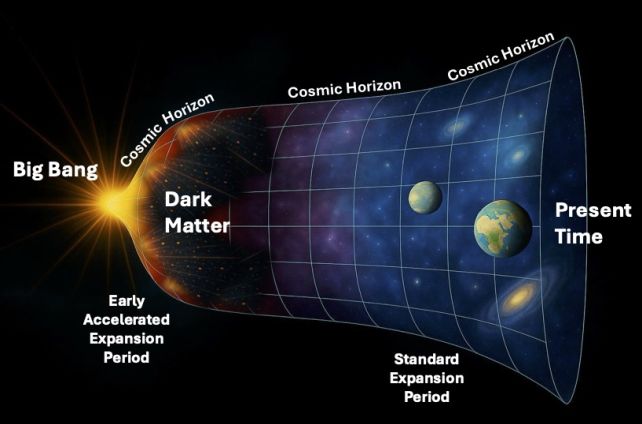Since conventional explanations have failed to pony up dark matter, one physicist is looking towards the unconventional.
In a series of two papers, physicist Stefano Profumo of the University of California, Santa Cruz has proposed two strange, but not impossible, origins for the mystery material responsible for the excess gravitational effects we see out there in the Universe.
In the first, published in May 2025, he proposes that dark matter could have been born in a dark matter 'mirror' of our own Universe, where matter is made of dark versions of particles akin to our protons and neutrons.
In the other, published in early July, Profumo proposes that dark matter particles could have formed at the boundary of the cosmic horizon – the edge of the observable Universe – during the rapid expansion following the Big Bang.
Related: Entire Planets Made of Dark Matter May Exist. Here's How We Can Find Them.
"Both mechanisms are highly speculative," he says, "but they offer self-contained and calculable scenarios that don't rely on conventional particle dark matter models, which are increasingly under pressure from null experimental results."

Dark matter is one of the most vexing problems in the cosmos. It neither emits nor blocks radiation, which means we have no way of detecting it directly.
With few clues to go on, we don't know what it is; we only know of its existence because somehow, the effects of gravity throughout the Universe are far stronger than they should be, once you've accounted for every galaxy, every star, and every cloud of dust drifting silent and dark between the stars.
Dark matter is the placeholder name we give to whatever it is that's responsible for this gravity excess, and there's a range of theoretical candidates to explain it, from planet-sized blobs to fleeting particles. However, in spite of avid and dedicated searches, none of the candidates have been verified.
For his new explorations of alternative dark matter candidates, Profumo turned to different realms of physics. For the first, he turned to quantum chromodynamics, which describes the strong force that binds quarks and gluons into particles like protons and neutrons.
According to this theory, a sort of 'mirror' universe exists within ours, where the strong force is replaced by a variation that binds fundamental particles hidden from our own Standard Model.
Under certain conditions in the early Universe, Profumo's paper expounds, concentrations of these hidden particles could grow dense enough to form dark matter black holes that would interact with our visible Universe only through gravity.

For the second paper, Profumo invokes quantum field theory at the cosmic horizon, sort of like a universe-scale version of the black hole's event horizon – the 'edge' of our observable Universe that we will never be able to probe beyond.
Following the Big Bang, the Universe underwent a period of accelerated expansion according to current cosmological theory. During this time, quantum fluctuations at the cosmic horizon could have spontaneously generated dark matter particles with a range of masses.
Both explanations are new and unconventional, but solidly based in current theory, and should be testable with future experiments. Further work is needed to refine the newly proposed models, but, Profumo says, they open up new possibilities for exploring and understanding the dark matter that suffuses the Universe.
Both studies have been published in Physical Review D. They can be found here and here.
